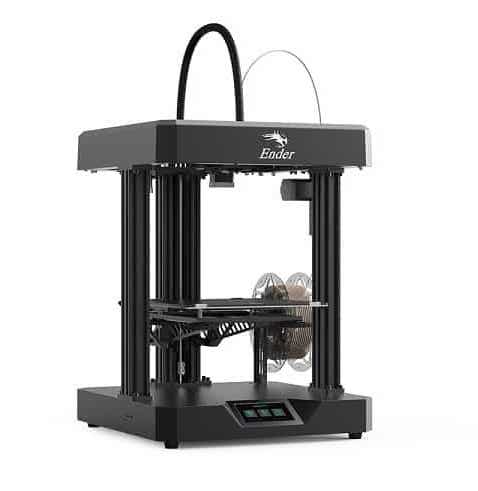Compare Ender 7 vs H2D
Comparison between the best 3D printers
Choose the best 3D printer at the best price. The cheapest 3D printers are here.
Buy a 3D printer here with 3D Fila.
 |
 |
|
| Model | Ender 7[BUY Ender 7] |
H2D |
| Printing Material | Filament | Filament |
| Buy Filament for Creality 3D Ender 7 | Buy Filament forBambu Lab H2D | |
| Estimated price | $429,00 | $1899,00 |
| Manufacturer | Creality 3D | Bambu Lab |
| Release Year | 2021 | 2025 |
| Print Volume [mm] | 250x250x300 | 350x320x325 |
| Printer Size [mm] | 430x460x570 | 492x514x626 |
| Weight [kg] | 17,2 | 42,3 |
| Power Loss Recovery | YES | YES |
| Enclosed printer | NO | YES |
| Bed Leveling | Manual | Automatic |
| Filament End Sensor | YES | YES |
| Bed type | Heated | Heated |
| Power supply system | Bowden | Direct Drive |
| Standard nozzle | 0,4 | 0,4 |
| Maximum Nozzle Temperature [°C] | 260 | 350 |
| Maximum Bed Temperature [°C] | 100 | 120 |
| Maximum printing speed [mm/s] | 250 | 600 |
| Filament holder | YES | YES |
| Camera for supervision | NO | NO |
| Recommended filaments | PLA, PETG, Tritan, Flex, ABS | PLA, PETG, ABS, ASA, TPU, PVA, Nylon (PA) |
| Recommended slicers | Cura, Simplify, Slic3r, IdeaMaker | Bambu Studio |
| Maximum Resolution [mm] | 0,1 | 0,01 |
| Processor | Creality CR-FDM V.2.4.S1_V101 32bits | |
| Display | Display touchscreen 4,3'' | Touchscreen 5'' |
| Power Supply | 110/220V / 350W | |
| Connectivity | SD / USB | Wifi, Bambu bus, Cartão SD |
| Operating systems | Windows, Mac, Linux | Windows, Mac, Linux |
| Date of registration in the system | 2022-11-04 | 2025-03-31 |
| Release date | 2021 | 2025 |
| Extra features | Crealitys Ender 7 printer offers remarkable print speeds, utilizing CoreXY kinematics for precise and fast movement. With a 250x250x300mm build area, dual direct extruder, and custom hotend, the Ender 7 is capable of printing at high speeds, although quality may suffer on smaller prints. Assembly is relatively straightforward, but the machine is noisy and can get hot. Its true speed potential is most noticeable on larger prints, where it outperforms its competitors. | Bambu Labs H2D combines high-speed 3D printing with a chamber heated up to 65 °C, dual extrusion with automatic nozzle switching, an AMS for filament drying and exchange, and AI sensors that detect failures. It offers optional laser and digital cutting capabilities, features intelligent calibration through computer vision, vibration control, enhanced fire safety, and real-time camera monitoring. |
| Support for multiple colors and materials (AMS and CFS) | NO | YES |
Notes * |
||
| Cost-benefit | 7 / 10 | 7 / 10 |
| Hardware | 2 / 10 | 7.2 / 10 |
| Tela | . | . |
| Print volume | 4 / 10 | 4 / 10 |
| Performance | 2 / 10 | 5 / 10 |
| [BUY Ender 7] |
Conclusion |
| In comparing the Creality Ender 7 and the Bambu Lab H2D, several key factors emerge that should guide a potential buyer's decision. Firstly, price is a significant consideration. The Ender 7, being considerably more affordable, presents an attractive entry point into 3D printing, especially for hobbyists or those new to the technology. Meanwhile, the H2D's higher price reflects its advanced capabilities and features geared towards professional users or serious enthusiasts who require greater versatility and performance. When it comes to print volume, the H2D has a larger build area, allowing it to handle bigger projects with ease compared to the Ender 7. Additionally, its automatic bed leveling and advanced features such as dual extrusion and enhanced print speed (up to 600 mm/s) cater to users who prioritize efficiency and high-quality outputs. Conversely, the Ender 7 relies on manual bed leveling and, despite its respectable maximum speed, does not match the H2D's capabilities in terms of versatility and high-performance printing. Another notable difference lies in build construction; the Ender 7 is not enclosed, making it less suitable for certain materials and environments that require temperature stability, while the H2D's enclosed structure provides better control over the printing environment. The Ender 7, however, is lighter and more compact, which may be favorable for those with limited space. Both printers feature Power Loss Recovery and filament end sensors, ensuring reliability during operation. However, the H2D's additional features such as intelligent calibration, enhanced fire safety, and the potential for laser and digital cutting give it an edge for users who require more from their machines. In summary, the choice between the Ender 7 and H2D ultimately depends on the user's needs and budget. The Ender 7 excels as a cost-effective option for beginners or hobbyists, while the H2D represents a more significant investment for serious users seeking advanced capabilities and high efficiency in 3D printing. |

